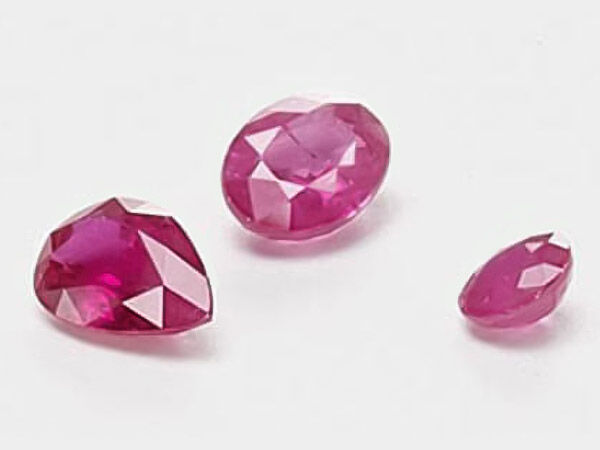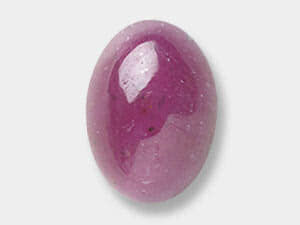Ruby Gemstone Meaning and Properties
Ruby Gemstone History
Ruby gemstone gets its name from the Latin word for red, ruber. It is one of the four precious stones along with diamond, sapphire and emerald. Ruby is the third hardest gemstone—with a Mohs rating of 9—after diamond and moissanite. For centuries, ruby gemstones have been mined, collected, traded, treasured and used in fashion, such as the breastplate of high priests and to adorn weapons. Ruby gemstone is known as the gemstone of nobles. "Blood red" ruby gemstones are considered the most valuable. In some ancient cultures, ruby gemstones were used to cast lots to predict the future. Famous ruby gemstones include the Estrela de Fura, a 55.22-carat ruby from Mozambique that became the most expensive ruby ever sold at auction, fetching $34.8 million in 2023.
Ruby gemstone is the birthstone for the month of July. It is also used to commemorate the 40th anniversary of weddings and other milestones such as, in 2013, the 40th anniversary of the founding of Fire Mountain Gems and Beads.
As the birthstone of July, delve into the captivating world of ruby gemstone. Discover the factors that contribute to its immense value, learn essential care and cleaning tips, and embark on a creative journey to craft your very own pair of exquisite ruby gemstone dangle earrings.

What are the Metaphysical Properties of Ruby Gemstone?
Ruby gemstone is believed to promote loving, nurturing, health, knowledge and wealth. It has been associated with improved energy and concentration, creativity, loyalty, honor and compassion. Ruby gemstone is thought to be protective of home, possessions and family. Ruby gemstone properties may include stimulating heart chakra and bringing spiritual wisdom while shielding against psychic attacks.
What are Ruby Gemstones Made From?
Ruby gemstone (along with sapphire) is part of the corundum species. It gets its red color from chromium. The red of ruby gemstone is the only color variety not found in sapphire. Also like sapphire, significant ruby deposits have been found in Southeast Asia (for centuries Burma, now Myanmar, was the main source), Eastern and Southern Africa, the Middle East as well as Pakistan, India, Sri Lanka, Australia and China.
Most deposits are still worked in the primitive way they've been worked for centuries. They are panned from rivers and picked out by hand from the other minerals around them.
In their natural rough form, ruby gemstones are dull, greasy-looking stones. But cut and polished, ruby properties include high luster (comparable to diamonds), and pleochroic rich red color. Pleochroic is color that varies when you view it from different directions.
Ruby gemstone in zoisite is a combination of ruby gemstone and zoisite crystal. The only mining deposits have been found in Tanzania. Ruby gemstone in zoisite typically displays a green color but can also have pink and red inclusions.
Another combination, ruby gemstone in kyanite (also called ruby kyanite) is mined in Myanmar (Burma), India and Thailand. Its color is typically a mottled pink and red with teal and green.
In addition to ruby gemstone in its natural state, some ruby gemstones are treated in two ways, dyed and heated.
Ruby gemstones of lower quality are sometimes treated with heat (approximately 3300 degrees Fahrenheit) to make gemstones more transparent and make the color more pronounced. Another treatment is filling fractures with lead glass to improve transparency.
Less often than heated, some ruby gemstones are dyed. The method of dyeing will vary by source, vendor and the technology. Typically, ruby gemstones, which are porous, are placed in vats of dye containing organic or vegetable dyes. Chemical salts and natural pigments may also be used. The stones may soak for several weeks to allow the dye to fully penetrate the stone and produce uniform surface color.
- Mineral Information: Aluminum oxide, Corundum group
- Chemical Composition: AI2O3
- Color: Deep red
- Hardness: 9 (Mohs)
- Specific Gravity: 3.97 – 4.05
- Refractive Index: 1.766 – 1.774
How Do You Clean Ruby Gemstones?
Clean ruby gemstones with lukewarm soapy water and a soft brush. Rinse the stone well after washing it. Ruby gemstones can be steam cleaned, but do not boil them. It is usually safe to use an ultrasonic cleaner. Although stable for normal wearing, untreated ruby gemstones can be etched by boric acid powder, and stones that have been dyed or have fractures or cavities can be damaged by mild acids such as lemon juice.
Ruby Gemstone FAQ
Q: Are ruby gemstones always red?
A: Ruby gemstones are always red, although the shade of red may vary.
Q: Do ruby gemstones crack easily?
A: Natural, untreated rubies are quite resistant to cracking, making them excellent for everyday wear—especially in rings and engagement settings. Just take the usual precautions against hard knocks.
Q: Where does the word “ruby” come from?
A: The name "ruby" comes from the Latin word ruber, meaning "red," a fitting tribute to the gemstone's vivid, fiery hue. This deep red color, which has long symbolized passion, power and vitality, is the defining feature of ruby gemstones and the reason behind their enduring allure throughout history.
Q: What is the Sunrise Ruby?
A: The Sunrise Ruby is a 25.59-carat Burmese ruby known for its vivid "pigeon blood red" color and exceptional clarity. Set in a Cartier ring and flanked by diamonds, it became the most expensive ruby ever sold at auction when it fetched $30.4 million in 2015. Originally mined in Myanmar and named after a poem by the Sufi mystic Rumi, the Sunrise Ruby is celebrated for its rarity and beauty.
Q: Can you use ruby gemstones in engagement rings?
A: Ruby gemstones make a stunning choice for engagement rings, especially because their rich red color symbolizes love, passion and deep emotional connection.
Designing with Ruby Gemstones
The ruby gemstones in Fire Mountain Gems' hand-faceted strands are pale shimmering red on the outside edge deepening to a vibrant deep red at their center. In cabochons and faceted stones, those rich red colors shimmer in all directions.
Although considered the gemstone of royalty, ruby gemstone can be worn with just about anything from a casual T-shirt to a formal dress.
According to Itten's Color Theory, brown (e.g. brown goldstone), orange (e.g. carnelian) and purple (e.g. amethyst) are analogous colors (and gemstones) to the red of ruby gemstone. That is, they are close to each other on the color wheel and can be readily combined with or substituted for each other. Green (e.g. emerald), is a complementary color to red (directly opposite on the color wheel) and provides a pleasing, yet high contrast effect. Yellow-green (e.g. peridot) and blue-green (e.g. blue-green fluorite) are split complementary colors to red, offering intriguing possibilities of complexity and sophistication.
Follow along with this detailed tutorial as we show you how to craft a beautiful ruby gemstone and rondelle bracelet using Accu-Flex® professional beading wire . Showcasing the vibrant charm of July’s birthstone, this project is perfect whether you're creating a meaningful gift or designing for your jewelry collection. You’ll see just how simple it is to make an elegant, eye-catching piece!

Shop for Ruby Gemstone
**Please note that all metaphysical or healing properties listed are collected from various sources. This information is offered as a service and not meant to treat medical conditions. Fire Mountain Gems and Beads® does not guarantee the validity of any of these statements.
How did you like this resource? Your feedback helps us provide resources that matter to you most.
Copyright Permissions
All works of authorship (articles, videos, tutorials and other creative works) are from the Fire Mountain Gems and Beads® Collection, and permission to copy is granted for non-commercial educational purposes only. All other reproduction requires written permission. For more information, please email copyrightpermission@firemtn.com.



